Pendergast T., Pendergast S. St. James Encyclopedia of Popular Culture. Volume 1: A-D
Подождите немного. Документ загружается.


COORSENCYCLOPEDIA OF POPULAR CULTURE
599
of the village in 1786. Another of Cooper’s works, The Chronicles of
Cooperstown (1838), provides a history of the village. The novel The
Deerslayer (1841) takes place at Otsego Lake during the beginning of
the French and Indian War.
An additional Cooperstown attraction, the Glimmerglass Opera
opened in 1975 with performances in the auditorium of the Cooperstown
High School. In 1987, the Alice Busch Opera Theater was completed
to permanently host the Glimmerglass, which has become an interna-
tionally recognized organization, producing performances for thirty-
six thousand opera fans during the summer festival seasons.
Overall, Cooperstown provides many opportunities to enjoy
American culture. Appreciating the music, viewing the scenery,
experiencing the American past in this historic village with its cultural
museums and the National Baseball Hall of Fame appeals to many as
an enjoyable diversion.
—Sharon Brown
F
URTHER READING:
Birdsall, Ralph. The Story of Cooperstown. Cooperstown, A. H.
Christ Co., 1920.
Cooperstown Chamber of Commerce. Visitor’s Guide. Cooperstown
Chamber of Commerce, Cooperstown, 1998.
Jones, Louis Clark. Cooperstown. Cooperstown, New York State
Historical Association, 1982.
New York State Historical Association, Main Street, Cooperstown: A
Mile of Memories. Cooperstown, New York State Historical
Association, 1992.
Smith, Ken. Baseball’s Hall of Fame. New York, Grosset and
Dunlap, 1958.
Taylor, Alan. William Cooper’s Town: Power and Persuasion on the
Frontier of the Early American Republic. New York, Alfred A.
Knopf, 1995.
Coors
‘‘Pure Rocky Mountain Spring Water’’ isn’t just a marketer’s
phrase; it is the ingredient that fueled Adolph Coors’ dream of owning
his own brewery in the 1870s, and then went on to make Coors the
third largest brewing company in the United States. It might seem
easy to dismiss Coors as just another brewery, but Coors has achieved
what many other companies—beer or otherwise—would cherish: a
mystique that reaches out to more than just beer drinkers.
Adolph Coors (1847-1929) was born in Barmen, Prussia, and
worked as an apprentice at the Henry Wenker Brewery in Dortmund,
Germany. In 1868, he fled a war-ravaged Germany to the United
States as a stowaway on a ship, and in 1872 he arrived in Denver,
Colorado, anxious to pursue his dream of owning a brewery. In
Golden, Colorado, along the banks of Clear Creek, he found the water
that he believed would make the finest tasting beer. Establishing his
brewery on the site it still inhabits today, Adolph Coors soon began
supplying beer to miners. During Prohibition, which began in Colo-
rado in 1916, Coors kept the business alive by selling malted milk, a
near-beer called Mannah, and the porcelain products that Coors
still produces.
With the death of Adolph Coors in 1929, Coor’s son Adolph Jr.
took over operations and, after Prohibition was repealed, he expanded
the market to ten Western states. In 1941, Coors introduced Coors
Light, but government restrictions due to World War II forced Coors
to limit product offerings. In 1959, Coors introduced the country’s
first all-aluminum can and got a jump on the ecologists by offering a
penny for each can returned for recycling. The mid-1970s brought
unrest and decline for the Coors company when Local Union #366
demanded a boycott of Coors beer. Sales dropped and, for the first
time in its history, employees were laid off. Although contract
negotiations revolved around wages and benefits, the company was
affected by bad press about Coors’ policy of making potential
employees submit to polygraph testing. Workers went on strike on
April 5, 1977. The strike officially lasted a little over a year;
unofficially it lasted much longer as the company continued to suffer
from bad press regarding its treatment of minorities and women, as
well as the breakup of the union. These allegations ultimately proved
untrue, and Coors was vindicated in 1982 when 60 Minutes inter-
viewed Coors executives and employees. Coors received a rare
favorable report from 60 Minutes and the judgment that it had been
the victim of a smear campaign by the AFL-CIO. An agreement
between Coors and the AFL-CIO finally was reached in 1987.
By the late 1970s, consumers were clamoring for a product with
fewer calories. In 1978, Coors reintroduced Coors Light, the beer
destined to become their number one product and one of the best-
selling beers in the country, creating a larger demand for Coors in
every state. In 1981, Coors expanded across the Mississippi and by
1991 had reached all 50 states. Operations were expanded to include
two new breweries—one in Virginia’s Shenandoah Valley, the other
in Memphis, Tennessee—both acclaimed for the high-quality water
that the Coors family would not compromise.
Coors achieved legendary, even cult, status in the 1960s and
1970s. This ‘‘mystique madness’’ may have started during World
War II. Believing that beer would help the morale of the troops, the
U.S. government subsidized breweries’ materials and costs. Coors
allocated half of its production to go overseas. When the war ended
and soldiers returned, the Coors beer they had become accustomed to
drinking was found in only the Western states, leaving soldiers to pine
over what they had left behind. A visit to Colorado eventually became
a way to smuggle the Rocky Mountain brew home. Former U.S.
President Gerald Ford was known to return to the White House with
several cases of Coors aboard Air Force One, as would his Secretary
of State, Henry Kissinger. Actor Paul Newman was often seen at
functions with a Coors in hand. The mystique of Coors beer was
featured in the movie Smokey and the Bandit, starring Burt Reynolds.
In the story line, Reynolds is challenged to smuggle a truckload of
Coors beer from Texarkana to Atlanta in 28 hours for a reward
of $80,000.
What began as a German immigrant’s dream in 1873 is now one
of the largest and most ethical corporations in America. Its philan-
thropic endeavors include environmental activities, start-up business-
es run by minorities, literacy programs, and veteran affairs. Not
content to limit these endeavors to outside interests, Coors also
supports better environments for its employees, such as its parental
leave policy, its Wellness Center, and its health benefits to partners of
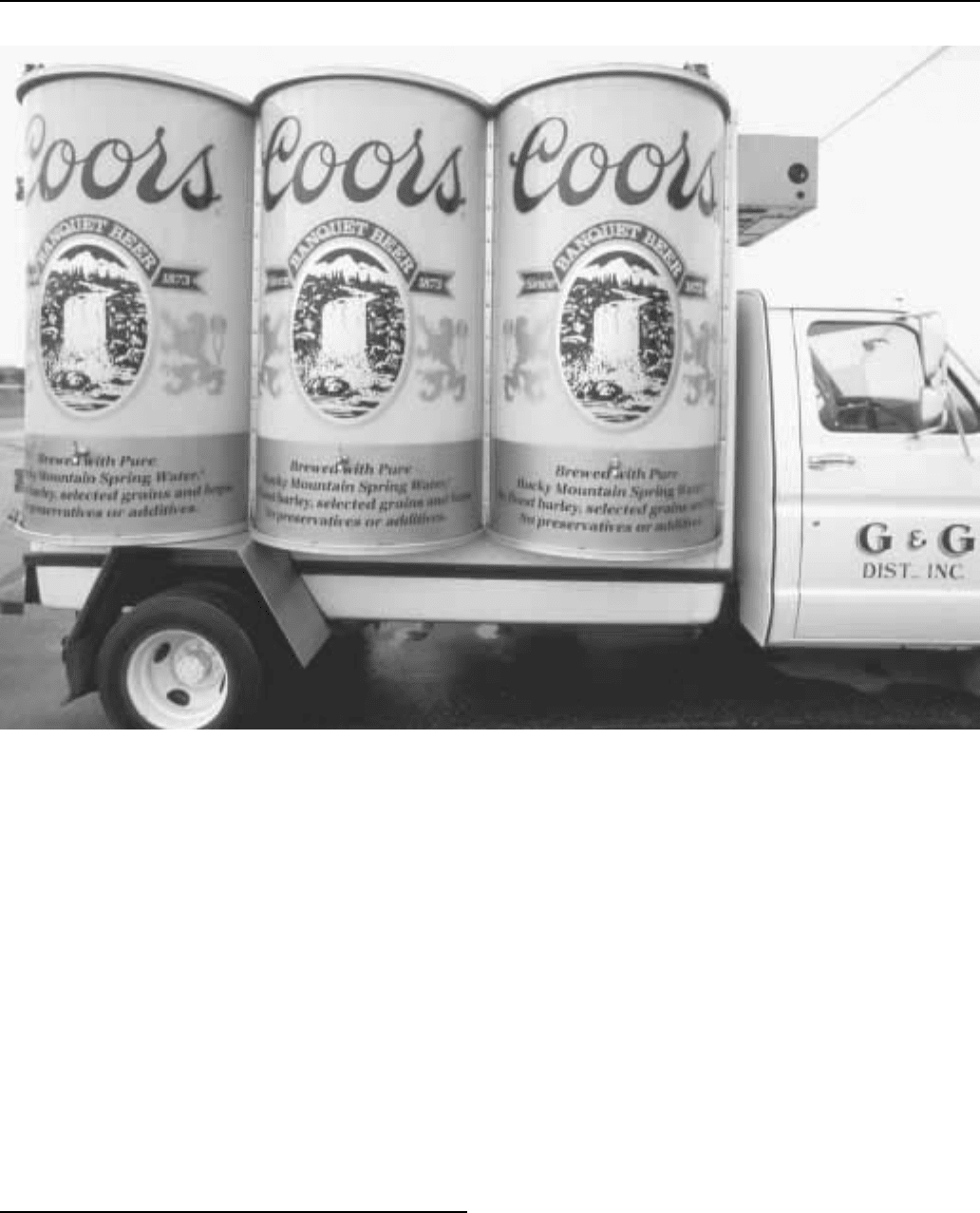
COPLAND ENCYCLOPEDIA OF POPULAR CULTURE
600
A truck carries three enormous Coors beer cans (each complete with its own tap).
gay and lesbian employees. But even though it is one of the largest
corporations in the country, the employees at Coors still talk about its
‘‘family feel.’’ The mystique lives on.
—Cheryl A. Smith
F
URTHER READING:
Banham, Russ. Coors: A Rocky Mountain Legend. Lyme, Connecti-
cut, Greenwich Publishing Group, Inc., 1998.
Van Munching, Philip. Beer Blast: The Inside Story of the Brewing
Industry’s Bizarre Battles for Your Money. New York, Random
House, 1997.
Yenne, Bill. Beers of North America. New York, Gallery Books, 1986.
Copland, Aaron (1900-1990)
One of the greatest American composers of the twentieth centu-
ry, Aaron Copland wrote music for American audiences with genuine
American themes. He changed the face of a composer’s lifestyle by
being involved in activities outside of the concert hall, and he wrote
music according to the popular trends of his time. This ability to tap
into the pulse of American popular culture elevated Copland to the
status of musical icon, although Copland was a humble man who did
not have the same ambition to acquire the huge audiences and fame
that other musicians sought out. Copland’s range of musical styles
was diverse, including jazz, opera, and American folk styles. He also
taught, lectured, and wrote books on musical topics. To him, music
was the ultimate symbol of passion and vigor in a personality.
Copland’s family came from Poland and Lithuania to the United
States in the 1870s. Aaron was born on November 14, 1900, the
youngest of five children. Harris and Sarah Copland, whose depart-
ment store earned the label ‘‘Macy’s of Brooklyn,’’ gave their
children a strong work ethic and a sense of orderliness and self-
determination that one can see in Copland over the course of his
musical career. As a youngster, he quickly realized his love for music
as he studied the works of Tchaikovsky, Debussy, and Ravel, among
others. He played the piano, and an older sister served as a tutor, but
he soon realized that he needed a professional musician if he was
going to make a career out of it.
Despite his father’s disappointment with his career choice,
Copland went to Paris in 1921 to study at the new music school for
Americans at Fontainebleau and take in the city’s rich, vibrant
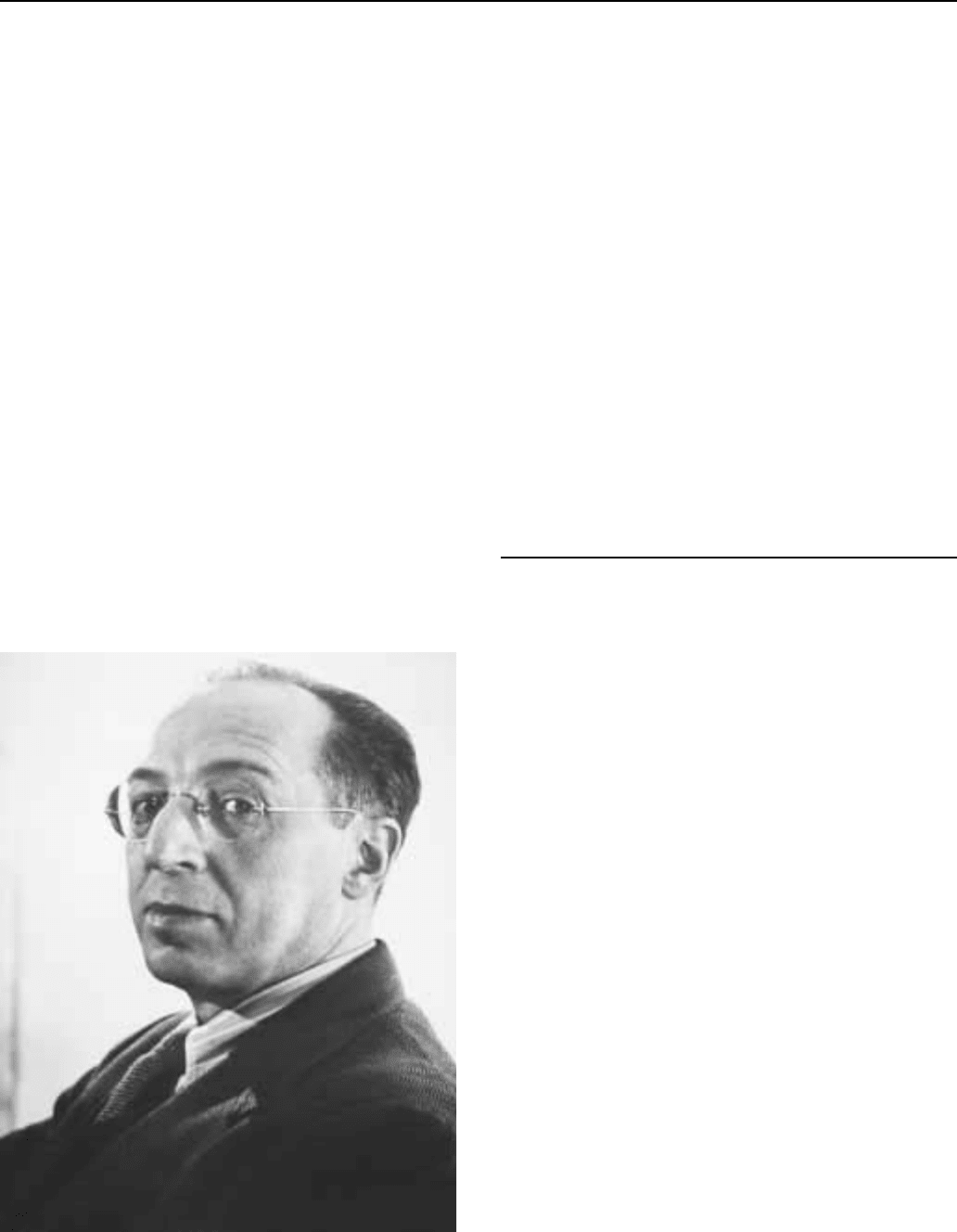
CORBETTENCYCLOPEDIA OF POPULAR CULTURE
601
culture. He studied harmony under a superb music instructor, Nadia
Boulanger. He toured other European cities such as Berlin and
Vienna, two world-famous musical centers, to take in as many
musical influences as he could. But Copland soon longed for New
York, and he returned to the United States in 1924.
During his years in Europe, Copland had formulated a better
contemporary understanding of music. He discovered that there were
vast differences in musical tastes between Americans and Europe-
ans—the music scene was much more energetic and accomplished in
Paris than in New York. Copland’s experiences enabled him to write
his first major piece, Symphony for Organ and Orchestra, in 1924,
which premiered with the New York Symphony Orchestra at Carne-
gie Hall in early 1925. Copland worked with jazz styles and rhythms
in his Music for the Theater (1925) and Piano Concerto (1926). He
showed a more abstract style in Short Symphony (1933) and State-
ments for Orchestra (1933-35). He changed his style in the following
decades and concentrated more on producing works with American
folkloric themes, which gained him a wider audience. His most
important works during these years included Billy the Kid (1938),
Rodeo (1942), and Appalachian Spring (1944). Copland also experi-
mented with opera: The Second Hurricane (a ‘‘play opera’’ for high
school students in 1937) and The Tender Land (1954). His most
famous orchestral scores include El Salón México (1936) and A
Lincoln Portrait (1942) with spoken excerpts from Abraham Lin-
coln’s famous speeches. Copland also composed music for films such
as Of Mice and Men (1939), Our Town (1940), The Red Pony (1949),
and The Heiress (1949, for which his score won an Oscar), and he
became known as one of the leading composers of movie scores.
Aaron Copland
Copland was the recipient of many distinguished commissions,
awards, and prizes, such as the Medal of Freedom in 1964 awarded by
the United States Government. Copland’s books include What to
Listen for in Music (1939), Copland on Music (1960), and a two-
volume autobiography with Vivian Perlis. Copland ceased compos-
ing after 1970 but continued to conduct, write, and lecture. He died in
Tarrytown, New York, on December 2, 1990.
—David Treviño
F
URTHER READING:
Berger, Arthur. Aaron Copland. New York, De Capo Press, 1990.
Butterworth, Neil. The Music of Aaron Copland. New York, Universe
Books, 1986.
Copland, Aaron, and Vivian Perlis. Copland: 1900 through 1942.
Boston, Faber and Faber, 1984.
———. Copland: Since 1943. New York, St. Martin’s Press, 1989.
Dobrin, Arnold. Aaron Copland: His Life and Times. New York,
Thomas Y. Crowell Company, 1967.
Corbett, James J. (1866-1933)
Professional prizefighting in the nineteenth century was a semi-
legal, bare-fisted fight to the finish, often featuring more wrestling
than punching. As the twentieth century approached, changes were
made, ostensibly to legitimize ‘‘boxing’’ as credible athletic competi-
tion. On September 7, 1892, in New Orleans, the first Heavyweight
championship match contested under the relatively new Marquess of
Queensberry rules took place. These new rules stipulated three
minute rounds with one minute rest periods and the use of five-ounce
gloves, worn to protect the combatant’s hands. A relic from the bare-
knuckle age by the name of John L. Sullivan—‘‘The Boston
Strongboy’’—was the reigning champion. Sullivan personified nine-
teenth-century America: rugged, racist individualism. He triumphed
in brutal contests of stamina and strength despite his heavy drinking;
he sauntered into saloons boasting ‘‘I can lick any man in the house!’’
and he drew the color line, refusing to fight leading black contender
Peter Jackson. Sullivan’s challenger, a fellow Irish-American pugilist
named James J. Corbett, seemed to personify the direction in which
boxing was moving, perhaps as a reflection of American society.
‘‘Gentleman Jim,’’ as Corbett would come to be known, both for his
style of dress outside the ring and his fighting style inside it, was born
on September 1, 1866 in San Francisco, California. The son of a livery
stable owner, he graduated high school but always found himself
fighting, first in the streets and then eventually at the San Francisco
Olympic Club. Where Sullivan was an east coast, blue-collar rough-
neck, Corbett was a west coast, white-collar scientific boxer, who
was employed as a bank teller when he began his professional
prizefighting career.
Corbett had earned his title shot with a win against an old bare-
knuckle nemesis of Sullivan’s, Jake Kilrain—with two wins against
contender Joe Choynski (who would go on to defeat the great Jack
Johnson); and with a 61 round draw with the same Peter Jackson
whom Sullivan refused to fight. Gentleman Jim toured the country,
fighting from San Francisco to Brooklyn, all the while clamoring for a
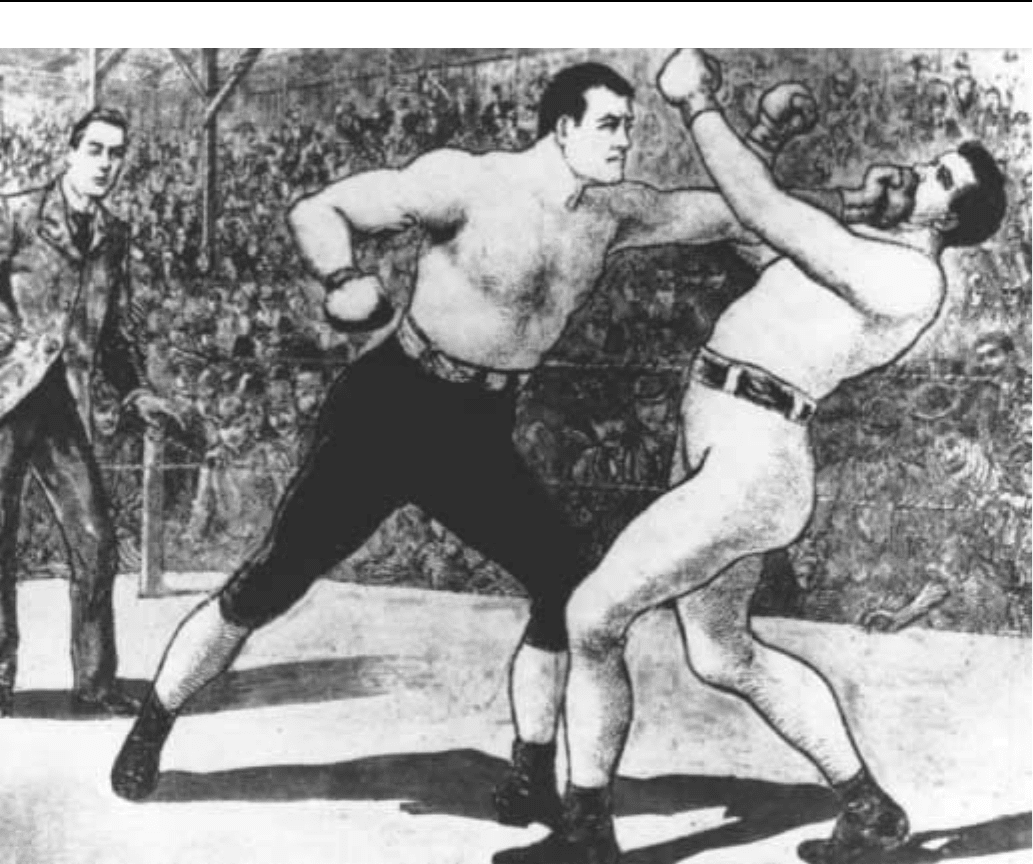
CORBETT ENCYCLOPEDIA OF POPULAR CULTURE
602
A reproduction of a fight between James J. Corbett (left) and John L. Sullivan.
match with the feared and beloved reigning champ. He got his chance
in New Orleans, where after 21 rounds Jim Corbett’s new-age science
prevailed over John L. Sullivan’s old-world machismo. In what
boxing historian Bert Randolph Sugar nearly a century later called
‘‘the most important round in boxing history,’’ the smaller, faster,
fitter Corbett claimed the heavyweight throne with a shattering
knockout. Modern boxing was born with this fight, as speed, condi-
tioning, and technique triumphed over brute force. Corbett, and
especially the Corbett-Sullivan fight, epitomized the evolution of the
fight game from a foul-plagued virtual free-for-all to a more organ-
ized contest of fists and wit. In a Darwinian twist, after the rules were
changed, Corbett-like fighters, who previously had not been as
successful as their larger and more powerful Sullivan-like counter-
parts, were now better adapted for success in boxing.
After his title winning effort, Corbett followed a path similar to
John L. Sullivan’s. Cashing in on his newfound fame, Corbett toured
in theater and vaudeville. By the time he defended his title against
Bob Fitzsimmons, Corbett had fought only once in the five years
since the Sullivan bout. Gentleman Jim lost his title to Fitzsimmons,
suffering a 14th round knockout. He made two attempts to regain the
crown, both against the big and powerful James J. Jeffries. In both
fights, Corbett’s ‘‘science’’ seemed at first to be carrying the day, but
the younger, fresher, Jeffries eventually caught up with the old boxing
master, winning with knockout’s in the twenty-third round of their
first fight and the tenth round of the rematch. With all of the changes
in boxing epitomized by Corbett’s defeat of Sullivan, there was one
aspect of the sport that no rule change could alter, one that remains
constant to this day: father time beats all comers.
—Max Kellerman
F
URTHER READING:
Corbett, James J. My Life and Fights. London, John Ousley, 1910.
———. The Roar of the Crowd. London and New York, Knicker-
bocker Press, 1925.
Heyn, Ernest V., ed. Twelve More Sport Immortals. New York,
Bartholomew House, 1951.

CORVETTEENCYCLOPEDIA OF POPULAR CULTURE
603
Corman, Roger (1926—)
The king of ‘‘B’’ movies, Roger Corman has produced and/or
directed more than two hundred films, half of which have made a
profit. After graduating from Stanford with an engineering degree,
Corman went into the movie business, working his way up from
messenger boy to screenwriter. After a studio tampered with his first
screenplay, he decided to produce his own films. The Monster from
the Ocean Floor (1954) established the Corman formula, as noted in
Baseline’s Encyclopedia of Film: ‘‘Quirky characters; offbeat plots
laced with social commentary, clever use of special effects, sets, and
cinematography; employment of fresh talent; and above all, minus-
cule budgets (under $100,000) and breakneck shooting schedules (5-
10 days).’’ Corman’s movies, such as The Little Shop of Horrors,
Machine Gun Kelly, and the six Edgar Allan Poe pictures starring
Vincent Price, became instant cult classics in the 1950s and 1960s.
Always quick to spot and sponsor talent, Corman formed his own
production company, which became a training ground for such A-list
directors and actors as Francis Ford Coppola, Martin Scorsese,
Jonathan Demme, Jack Nicholson, Robert De Niro, and Dennis
Hopper. With his eye for talent, knack for business, and willingness to
take risks, Roger Corman made low-budget movies a staple of
American popular culture.
—Victoria Price
F
URTHER READING:
Arkoff, Samuel Z., and Richard Trubo. Flying through Hollywood by
the Seat of My Pants. New York, Birch Lane Press, 1992.
Corman, Roger, and Jim Jerome. How I Made a Hundred Movies in
Hollywood and Never Lost a Dime. New York, DaCapo Press, 1998.
Monaco, James, and the editors of Baseline. Encyclopedia of Film.
New York, Perigee, 1991.
Corvette
In 1953 General Motors introduced the Chevrolet Corvette
sports car, America’s first mass-produced automobile with a fiber-
glass body. With its sleek design and Americanized European styling,
it quickly became the ‘‘dream car’’ of thousands of auto enthusiasts.
Though the economy was experiencing a postwar boom in automo-
bile sales, the base price of $3,498 was prohibitive for many, and only
300 Corvettes were produced the first year. In 1960, its popularity was
enhanced by a television series called Route 66 (1960-1964), which
featured two adventurous guys—actors Martin Milner and George
Maharis—tooling around the country in a Corvette.
The car was the brainchild of Harley Earl, an auto designer who
had made his name turning out one-of-a-kind car bodies for movie
stars. Earl’s first design after joining General Motors was the spec-
tacular 1927 Cadillac LaSalle, which was to help convince the
automobile industry of the importance of styling. He scored another
design coup by putting tail fins on the 1948 Cadillacs, making him the
top man in GM styling and giving him the clout to persuade the
company to build an entirely new car. Earl noticed that GIs had
brought back a distinctive kind of automobile from Europe, a sports
car that was fun to drive and had become a kind of cult object to the
owners who gathered to race them on dirt tracks. Detroit made no
vehicle to compete with the popular two-seat sports cars such as the
MG and Jaguar until Earl convinced his bosses to let him build an
American sports car to present at the 1953 Motorama, GM’s traveling
show. GM executives agreed after insisting that standard GM parts be
used under its proposed fiberglass body. Legend has it that the
designers cleared away a ping-pong table and in one night ‘‘laid out
the whole skin for the first Corvette.’’ After discarding almost three
hundred suggestions for a name, they selected Corvette, the name of a
swift fighting ship in the old British navy.
Despite the secrecy surrounding the new Corvette, word leaked
out to sports car enthusiasts, and in January, 1953, long lines of
curious car buffs waited outside the Waldorf-Astoria Hotel in New
York City for the Motorama to open. The 300 original models were
polo white convertibles with red interiors, and all handmade body
panels. The critics pronounced them beautiful, but not very satisfacto-
ry as sports cars due to an inadequate, rough-riding suspension
system. They proved, however, to be superb investments, and those
still owned by collectors are said to be worth more than $100,000
each. The number of original 1953 cars still existing is variously
estimated at 120 to 290.
The engineering problems persisted, and in 1954, only half of the
output of 3600 Corvettes were sold. A former racer on the European
circuit, Zora Arkus-Duntov, came to GM’s rescue by writing a memo
to GM executives outlining the Corvette’s shortcomings and urging
the company to create a separate department within Chevrolet to
oversee the Corvette’s development. After GM hired Duntov for its
Corvette project, his first step was to put a V-8 engine in the 1955
model, and that year GM sold all 700 of the Corvettes that were built.
Duntov went on to become Corvette’s first chief engineer. In
1956 he replaced the automatic transmission with a three-speed
manual, and the car became one of GM’s hottest sellers. Corvette
owners raced and defeated Jaguars and other European cars, and a
modified 240 hp 1956 Corvette—with Duntov driving—set a record-
breaking average of 150.583 mph at the Daytona Beach raceway.
John Fitch drove a standard Corvette to a new production-car record
of 145 mph during Daytona Speed Week in 1956. Later that year, in
the 12 Hours of Sebring race, a Corvette showed its durability by
winning first in its class. In 1960 three white Corvettes competed in
the 24 Hours of LeMans race in France, finishing eighth overall. A
1968 Corvette reached a speed of 210.762 mph in the 1979 Bonneville
Speed Week at the Utah Salt Flats, becoming the fastest carbureted
car in the world.
The 250,000th Corvette, a gold convertible, rolled off the
assembly line in 1969. Although Harley Earl had retired in 1958,
being replaced as chief stylist by Bill Mitchell, the car underwent
redesigns in 1963, 1968, and 1984. It was Mitchell who got the idea
for the body shape of the XP-775, the Corvette Shark, after landing
such a fish in deep sea off the Bahamas. The 500,000th Corvette was
built in 1977, and the following year a Corvette was used as the pace
car for the 62nd Indianapolis 500. In June of 1978 a movie, Corvette
Summer, premiered in Maumee, Ohio, attracting a parade of Corvette
owners that made the Guinness Book of World Records, the number
estimated at between five and seven thousand cars. That October,
another movie, High Rolling in a Hot Corvette, was released.
Into the 1980s the Corvette turned a profit for GM of about $100
million with a small production of around 25,000 cars annually. The
Corvettes continued to act as a proving ground for new suspensions,
new electronics, new chassis fabrication techniques, and new fiber-
glass or plastic materials for body parts. The Corvette sold out nearly
every year, and Corvette clubs worldwide were filled with proud
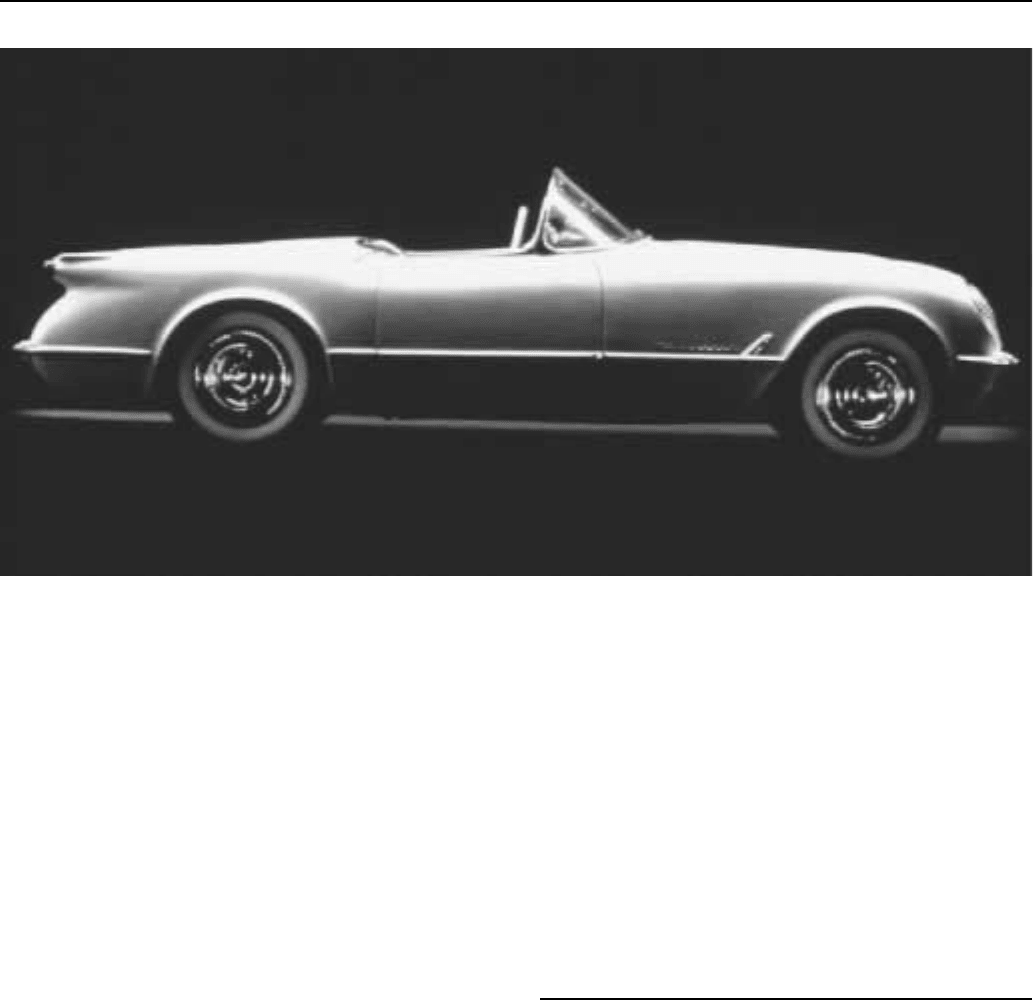
CORWIN ENCYCLOPEDIA OF POPULAR CULTURE
604
The 1953 Corvette
owners who esteemed the cars and hailed the arrival of each new
model, despite nagging problems such as rattles in the removable
hardtop and the resistance of the fiberglass body to durable paint.
In the early months of 1989 was begun the long process of
developing a new Corvette from scratch. The dream of developing the
C5, the fifth-generation Corvette, coincided with a time of financial
disaster at General Motors, which reported a $2 billion loss in 1990
and predicted even worse results in 1991. Despite this fiscal situation,
new competitions were launched to design a C5 Corvette. The next
five years proved to be a roller-coaster ride for the prototype due to
internal rivalry at GM and budget cutbacks. Problems emerged
involving the lubrication of the all-new aluminum engine, the elec-
tronic throttle control, and a new fiberglass side structure that failed to
pass early tests in the crash laboratory. By 1996 the problems were
solved, and C5s were being tested in long-distance drives throughout
the United States. In Australia the new model Corvettes were set on
cruise control in 110-degree heat and run on the outback roads for 90
to 120 minutes straight, with no problems.
When the new fifth-generation, cherry-red Corvette was un-
veiled at the Motorama Show the following January, fans were
ecstatic about the car’s new silhouette and its all-new 5.7-liter V8
345-hp engine, capable of moving from zero to sixty miles per hour in
five seconds and delivering a top speed of 172 mph. Though it was
still unmistakably a Vette, the wheelbase was longer, and the nose had
been lowered for greater aerodynamics and road visibility. The new
design reflected the sleekness of the ‘83 Corvette and the muscle of
the ‘68 model. Other links to past Corvette generations included the
air scoop on the front quarter panel, the familiar quad taillamps, and
the concealed headlamps. The new version has one-third fewer parts
despite the addition of a four-channel anti-lock braking system and
complex traction control. Automobile writers raved about this sports
car that was ‘‘as comfortable as a limousine.’’ GM boasted that with
all the improvements, the $44,990 sticker price was $635 less than the
1996 Corvette.
—Benjamin Griffith
F
URTHER READING:
Adler, Dennis. Corvettes, 1953-1995. New York, Krause, 1996.
Schefter, James. All Corvettes Are Red: The Rebirth of an American
Legend. New York, Simon & Schuster, 1996.
Zeichner, Walter. Chevrolet Corvette, 1953-1986. New York,
Schiffer, 1990.
Corwin, Norman (1910—)
Throughout the 1940s, Norman Corwin elevated the fledgling
medium of live broadcast radio theatre to its artistic zenith in
America. Regarded as radio’s poet laureate by fans and contemporar-
ies, Corwin’s earnest prosody adapted naturally and easily to radio
broadcast, and he wielded the medium to its utmost, celebrating the
American citizen during World War II, elucidating the dread of war
with a journalist’s precision, impugning despotism, or merely lending
credence to the vox populi with his intellectual, imaginative use of
words, music, and dramatic interplay. Corwin’s dramatic use of radio
defined an era and an art form. Though Corwin was revered and
admired during radio’s Golden Age, his popularity ultimately paral-
leled that of network radio.
Born May 3, 1910, in Boston, Massachusetts, Norman Lewis
Corwin was the third of four children in a Jewish Russian-Hungarian
family. He was a prankster and a storyteller, and his grades in school
were uneven, though teachers discovered early his talent for writing
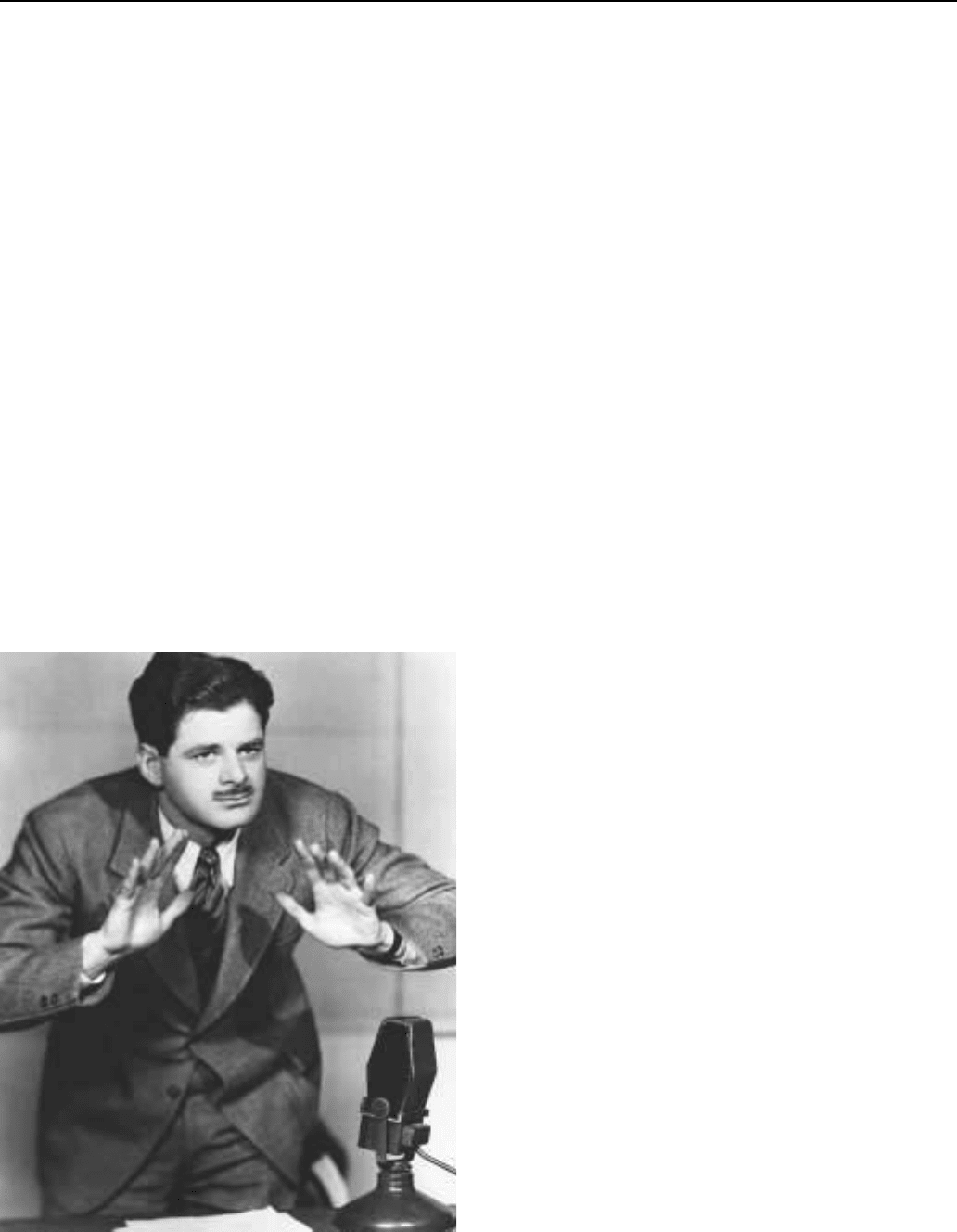
CORWINENCYCLOPEDIA OF POPULAR CULTURE
605
and appreciation for poetry. Upon graduating from high school,
Norman wrote for the Springfield Republican covering human-
interest stories. When infant station WBZA requested that the news-
paper provide a radio news reader, Corwin was assigned, and soon he
was producing a poetry program—Rhymes and Cadences—while
writing newspaper articles and radio copy as well as his first (failed)
attempt at a novel. But at twenty-one, Corwin was restless and
traveled to Europe with his brother and a friend.
In Germany, in the shadow of World War I, Corwin reflected on
the senselessness of war, the ethnic hatred growing in the Weimar
Republic, and the political pessimism spreading into adjacent nations.
When Corwin returned to the States, his idealism resolved into a sense
of purpose, a defiance of inevitability. In 1935 he began reading news
on WLW in Cincinnati, Ohio. Less than three weeks later, though, he
was fired for challenging a managerial memo forbidding the an-
nouncement of a local labor strike. He returned to the Republican, but
not for long.
Arts, education, and social service organizations were accusing
commercial radio stations of polluting the airwaves with a huckstering
orgy, serving their own financial interests, and neglecting the quality
of their programming. Faced with losing their licenses in a proposed
decentralization of frequencies, many stations began hiring writers
and directors to expand the formulaic format of commercial broad-
casting with ‘‘sustaining programs’’ for discerning audiences.
After a brief stint as a publicity writer for Twentieth Century-
Fox, Corwin was hired by the Columbia Broadcast System in 1938
and immediately proved himself a considerable talent, writing (in
verse) and directing a fanciful play called The Plot to Overthrow
Norman Corwin
Christmas on his new program Words without Music. Later he
impressed even the venerable CBS newsman Edward R. Murrow with
They Fly through the Air with the Greatest of Ease, a sharp response
to the indifference of Italian bombardiers. Corwin went on to produce
and direct the Columbia Workshop, showcasing some of the finest
writers, actors, and musicians available.
In 1941, Corwin wrote, directed, and produced a live broadcast
each week for the eponymous 26 by Corwin series. With unprecedent-
ed autonomy—network censors literally had no time to review his
scripts prior to broadcast—Corwin spun each whimsical, fantastic, or
dramatic tale, often reminding listeners of the war a horizon away.
Later, Corwin produced a celebration piece for the 150th anniversary
of the Bill of Rights (‘‘We Hold These Truths’’) to be aired on all four
networks simultaneously and starring Hollywood luminaries James
Stewart, Edward G. Robinson, Marjorie Main, Orson Welles, and
many others, as well as president Franklin D. Roosevelt. On Decem-
ber 7, 1941, however, the Japanese attack on Pearl Harbor caught the
nation by surprise, and Corwin retooled the program into a galvaniz-
ing documentation of American political determination. Eight days
later, more than sixty million people heard ‘‘We Hold These Truths’’
as America’s position on the war became clear: we would fight.
Throughout World War II, Corwin churned out poignant drama-
tizations of patriotism and thrilled audiences with his candor and
eloquence. His series This Is War! (1942) was considered radio’s first
all-out effort at wartime domestic propaganda, and his series An
American in England, coproduced on location by Edward R. Murrow,
brought the human faces of shell-shocked Britain into American
homes. In 1944, CBS broadcast Columbia Presents Corwin, a collec-
tion of war-inflected plays similar to the 26 series.
When the war in Europe ended, Corwin had prepared a special
broadcast for V-E Day, May 8, 1945. Refraining from wild celebra-
tion, as the war was still alive in the Pacific Theatre, ‘‘On a Note of
Triumph’’ asked tough moral questions of both citizen and govern-
ment in a relentless prose poem equally evaluating America’s losses
and victories punctuated by sound effects and a powerful score by
Bernard Hermann. For V-J Day, after the first atomic bombs were
dropped on the cities of Hiroshima and Nagasaki, and Japan subse-
quently surrendered, Corwin created a solemn closure piece called
simply ‘‘14 August’’ (1945), ‘‘a fistful of lines’’ delivered by
Orson Welles.
After the war, Corwin received the first Wendell Wilkie One
World award and traveled the war-torn globe recording his impres-
sions, producing from these tapes the series One World Flight (1947).
Corwin’s association with CBS ended in 1948 when the network
began to compromise his artistic integrity. He joined United Nations
Radio in 1949 amid a national obsession with Communism in which
Corwin himself ironically was suspect and created Pursuit of Peace
(1950), a series which espoused the unity of the world’s nations.
As radio became less lucrative and as the medium of television
captured America’s imagination, Corwin faded from public view.
Though he authored more than seventeen books and wrote numerous
screenplays, he could never recapture the immediate glory of radio’s
Golden Age. His programs have long been in circulation among old-
time radio enthusiasts, however, and in the 1990s National Public
Radio rebroadcast many of his works to commemorate the fiftieth
anniversary of World War II and even commissioned new plays
created by this bard of the airwaves.
—Tony Brewer

COSBY ENCYCLOPEDIA OF POPULAR CULTURE
606
FURTHER READING:
Bannerman, R. LeRoy. Norman Corwin and Radio: The Golden
Years. Alabama, University of Alabama Press, 1986.
Dunning, John. On the Air: Encyclopedia of Old-Time Radio. New
York, Oxford University Press, 1998.
Maltin, Leonard. The Great American Broadcast: A Celebration of
Radio’s Golden Age. New York, Dutton, 1997.
Stuart, Lyle. 13 for Corwin: A Paean of Praise for Norman Corwin,
the #1 Writer-Director-Producer during Radio’s Golden Age.
New Jersey, Barricade Books, 1985.
Cosby, Bill (1937—)
As one of the most influential and gifted comics of his time, Bill
Cosby dissolved racial barriers on television from the 1960s to the
1980s, created the epochal situation comedy The Cosby Show,
produced memorable educational programs for children, and made a
series of much adored advertisements. Cosby’s enormously influen-
tial style as an on-stage comic influenced a generation. On the 1968
album To Russell, My Brother, Whom I Slept With, Cosby’s comedy
brings everyday experience away from any broader historical mean-
ing to the level of the mundane and thus, the ‘‘universal.’’ This quality
of universality helps to account for his ability to traverse ordinarily
sensitive racial, gender, and age divides with ease and grace.
Bill Cosby
In the style developed during his early years performing at
nightclubs and recording a number of successful comedy albums,
Cosby became his audience in their most ordinary, everyday aspects.
Aware that while there were others who could tell ‘‘jokes’’ as well as
or better than he, Cosby’s inimitable signature was the domestic
anecdote—a charming and instantly recognizable little tale of every-
day family experience. Cosby remembers experience to such a degree
that he revitalizes it.
Cosby deliberately eliminated anything in his comic presenta-
tion that might have divided his audience. According to biographer
Caroline Latham, Cosby explained during an interview in the 1960s
why he does not do ‘‘racially oriented material’’: ‘‘When I told racial
jokes, the Negroes looked at the whites, the whites looked at the
Negroes, and no one laughed—until I brought them together again,
and then I had to tell the jokes over again. . . I try to find a common
identity with an audience. I create a situation and say, ’Hey, this
happened to me and you’re laughing with me about it, so can we really
be that different?’’’
Born William Henry Cosby, Jr. on July 12, 1937, Cosby grew up
in a rough part of Philadelphia essentially a fatherless child. When
Cosby was eight years old his six-year-old brother died. Bill’s father
retreated from this unbearable reality and joined the Navy, leaving his
family in dire financial straits. Whatever money he sent home was
woefully inadequate to the family’s needs and they slid quickly down
the economic ladder, occasionally landing on the welfare rolls. Not
long after what must be considered a desertion, Cosby’s mother
obtained a divorce.
‘‘My father left home many times,’’ Cosby has said. ‘‘He would
leave home when the rent was due, or come home penniless on
payday, swearing to my mother that he’d been robbed and leave
again. Once he vanished just before Christmas and we didn’t have a
cent.’’ Cosby’s mother Anna assumed the role of family breadwinner
and Bill, as the oldest child, was left to ‘‘mother’’ his younger
siblings. He cooked, cleaned, and kept order among the kids. Latham
quotes Cosby’s brother Russell: ‘‘He kept us in line and whipped us
when we got out of line.’’ His boyhood responsibilities as a caretaker
were not something he could either take or leave. It was his responsi-
bility to keep everyday domestic life going. The small joys and pains
of this life were as much his experience as they are for any ‘‘mother.’’
The structure of Cosby’s comedy is rooted in his communication of
this experience.
In the routines he would later fashion for the stage, his albums,
and for the 1984-1992 sit-com The Cosby Show, his portrayals of
family life are always idyllic. Annoyance is most often involved but
never despair or genuine frustration. The one word observers use to
describe the experience of Cosby’s comedy more than any other is
‘‘reassurance.’’ In Cosby’s comedy there is always a sort of small
internal war waged between his desire to relate the feel of his actual
experience and his apparent need to suppress that experience with a
fantasy of patriarchal authority that clearly did not exist for him when
he was a child.
Initially a high school dropout, Cosby signed up for a four year
Navy hitch when he got his equivalency diploma. . . and did not stop
there. While most celebrities settle for honorary degrees, Cosby later
returned to college and got his bachelors, masters, and Ed.D. Educa-
tion became a dragon Cosby would be forever trying to slay; during
his career, he always maintained his interest in creating educational
programming such as the beloved cartoon Fat Albert and The
Cosby Kids.

COSBY SHOWENCYCLOPEDIA OF POPULAR CULTURE
607
After two years on a track scholarship at Temple University,
Cosby started telling jokes professionally, and within a short time
became television’s Jackie Robinson in his role as Alexander Scott in
the NBC series I Spy (1965-68). It was the first time an African
American character had so significant a role on a television series.
While appreciative of the opportunity, Cosby had some reservations
about how the character was written: ‘‘If Alexander Scott doesn’t get
to go out with a girl once in a while,’’ Cosby complained at one point,
‘‘people are going to wonder about me.’’ According to Latham,
Producer Sheldon Leonard (the Branch Rickey of television) re-
sponded: ‘‘I am not going to feed the concept that says a Negro only
responds to the sex drive. We want him to have girls, but there has to
be sweetness and dignity to it.’’
During the 1970s, while Cosby worked toward his doctorate at
the University of Massachusetts at Amherst, he fashioned a new
comedy routine apparently based on his domestic experiences as a
father of four daughters and one son. He used the substance of the
routine as the foundation for his enormously popular and structurally
groundbreaking television series, The Cosby Show. The show focused
almost entirely on the often-overlooked yet familiar everyday activi-
ties of an ordinary, intact upper-middle-class African American
family. No such family had ever before been depicted on American
television and the show became a landmark success. Cosby finally
had a fitting vehicle to fully realize his comic potential and appeal to
virtually all segments of American society.
After the show finished its run in the early 1990s, Cosby soon
had another sitcom—named simply Cosby—that became a moderate
success. Then, on the morning of January 15, 1997, Cosby’s only son
Ennis—the model for the fictional ‘‘Theo’’ of The Cosby Show—was
shot to death by a man who tried to rob him. Bill Cosby took virtually
no time to mourn in private; neither his on-stage nor off-stage attitude
could help him confront an experience so far outside of the familiar
everyday world he created in his work.
—Robin Markowitz
F
URTHER READING:
Adler, Bill. The Cosby Wit: His Life and Humor. New York, Carroll
and Graf, 1986.
Cosby, Bill. Time Flies. New York, Doubleday, 1987.
Fuller, Linda K. The Cosby Show: Audiences, Impact, and Implica-
tions. Westport, Connecticut, Greenwood Press, 1992.
Latham, Caroline. Bill Cosby—For Real. New York, Tom Doherty
Associates, 1985.
Smith, Ronald L. Cosby. New York, St. Martin’s Press, 1986; revised
edition, Amherst, New York, Prometheus Books, 1997.
The Cosby Show
The Cosby Show, a situation comedy that ran for eight seasons on
NBC Television, was one of the most intensely and immediately
popular shows ever broadcast in America. The show, which began in
the fall of 1984, featured comedian Bill Cosby in the role of
obstetrician-father Cliff Huxtable and his family: attorney-wife Claire,
daughters Sondra (18), Denise (15), Vanessa (11), Rudy (5), and son
Theo (13). According to the December 5, 1985 issue of USA Today,
the program premiered at the number one spot on the Nielson ratings,
reached that spot ten times during the first season, and was number
one in every age group. An estimated 62 million people tuned in every
Thursday night during the early years of the show’s run. More
significantly, The Cosby Show was the first American television show
to feature the daily adventures of a prosperous, intact upper-middle
class family of African descent.
The source of the show’s popularity and significance in televi-
sion history stemmed not from Bill Cosby’s own intentional presenta-
tion of the ideology of African-American upward mobility and the
restoration of traditional family values to popular culture, but in the
sheer pleasure of the nearly plotless structure of the show. On The
Cosby Show, the focus on the seemingly ‘‘insignificant’’ bits of
business of everyday life became the show’s main attraction. It was
truly the first ‘‘show about nothing’’ that Seinfeld later claimed to be.
The first several episodes were drawn almost without alteration from
Cosby’s early 1980s stand-up routines and it is primarily from his
comic vision that the show emerged whole. The show created a safe,
crisis-free world that viewers had a chance to enter for a half-hour
every week. Regardless of their ethnicity, gender, or age, many
viewers immediately recognized themselves in the show: the Huxtable
characters enacted the strikingly real ordinary domestic activities of
the viewing audience. In its mid-1980s heyday, Thursday night
became ‘‘Cosby night,’’ a time anticipated with relish.
Only one family comedy before The Cosby Show came close to
this structural breakthrough. The Adventures of Ozzie and Harriet
(1951-1966) portrayed a ‘‘real’’ family who ‘‘played themselves,’’ as
it were. These shows were relaxed in the extreme and the Nelsons
themselves seemed to exist in a state of grace; Ozzie, the ‘‘head of the
household,’’ never seemed to have an occupation and simply saun-
tered around the house all day. He lived the domestic life of a retired
man with a servant (Harriet). There was, more importantly, some
slight shift of focus to the everyday ‘‘doings’’ of life rather than on a
very tight plotline. We see here only a glimmer of what The Cosby
Show would bring to fruition and Seinfeld would later be so widely
noted for.
One early episode of The Cosby Show, which concerned Cliff’s
looking after a slumber party of five-year-olds, disposed of some five
to ten minutes of Cliff playing ‘‘bucking bronco’’ with the children:
that is, bouncing some ten of them, one at a time, upon his knee.
Someone connected with the show told T.V. Guide in 1985 that it was
‘‘one long Jello commercial.’’ The episode was perhaps the most
loosely scripted sitcom episode ever produced: the audience simply
delighted in watching Bill Cosby make real children laugh. At this
point, it was clear that the show’s meandering tone was no mistake, no
bug that needed to be worked out (as one might have originally
suspected), but in fact, the very secret of show’s success. Watching
The Cosby Show, it appeared as though the cameras were simply stuck
in a window, left on, and the finished product assembled at random.
Viewers of the show luxuriated in a sort of celebration of banal,
ordinary existence and thus participated in a validation of their own,
often-overlooked daily life.
The most fascinating aspect of this is that the show’s creators
seemed utterly unaware of the reasons why people were glued to their
show. Bill Cosby, for his part, told Larry King in 1989 that the show
was successful because now the parents always get to ‘‘win.’’ He
reported his distress at programs such as Silver Spoons that depicted
weak, incompetent parents led around by clever children. Cosby saw
himself as the avenging parental Rambo of domestic comedy. The
world the show created stands however, quite apart from (and indeed,
opposed to) the ideological message Cosby sought to deliver.

COSELL ENCYCLOPEDIA OF POPULAR CULTURE
608
What distinguished the Cosby show from virtually all others in
the family comedy genre was the almost total absence of struggle or
conflict. There is a sense that some measure of real suffering and
discord occurred in the past, in previous generations, but not any-
more. The grandparents’ function in the show is to give some hint of
this, as is the display of various icons scattered about the Huxtable
home. A picture of Martin Luther King, Jr. reposed on the wall of
eldest daughter Sondra’s room and in another episode all of the trivial
action stopped dead in its tracks when King’s 1963 ‘‘I Have A
Dream’’ speech appeared unexpectedly on the living room TV
screen. It was as if the savior himself had appeared in an apparition.
The message was clear: without that struggle, the Huxtables idyllic
existence would not be. Now, of course, all struggle is ended. If ever
there were an ideal representation of Reagan-era complacency,
this was it.
‘‘Significant’’ things seem to actually go on beyond the door of
the Huxtable household, but almost never within its borders. The
Huxtables experienced only the banal, uninterrupted hubbub of the
everyday, only those aspects of life to which real people rarely give
much thought and attention. Every Thursday night during the show’s
run we watched the children’s endless squabbles, activities useful
mainly in their ability to allay boredom (playing chess, shooting
baskets), recreational cooking (Cliff’s Special Secret Spaghetti Sauce),
and the annoyances—but never the life-altering burdens of working
parents caring for a young child. In a memorable vignette, Cliff asks
five-year-old Rudy if she needs to use the bathroom before he puts her
into her elaborate snowsuit and, of course once she’s zipped into it,
she exclaims, giggling, ‘‘I have to go to the bathroom!’’ An exasper-
ated Cliff sent her to her mother.
Observers eventually tried explaining the unprecedented success
of the show by suggesting that its success reflected ‘‘the love in the
house.’’ In fact, a record album released during the show’s heyday of
theme music connected with the program is called A House Full of
Love. The reason for this is not the adequacy of the explanation, but
Cliff’s use of the language of ‘‘love’’ to diffuse any potential conflict.
We love each other; therefore we cannot have a problem.
In the alternative universe of the Huxtables, it is clear, problems
are only apparent: they can’t really exist. In one episode, Claire
knocks 14-year-old son Theo’s notebook off the kitchen table. A
marijuana joint falls out of the book. The parents look at each as if the
sky has fallen. This cannot be happening in our house! Our house full
of love! Theo is summoned to make some explanation of the event.
He tells them it is not his and they believe him. (Huxtables, like
George Washington, cannot tell lies.) This does not thoroughly
satisfy Theo, who fears the loss of his parents’ trust, so he drags the
culprit who hid the joint in his book home with him to explain the
situation to his parents. Cliff tells the boy from the errant outside
world to see some adult about his problem—perhaps even the good
doctor himself. It was not possible for Theo to have been the affected
youth. Things like that did not happen to Huxtables.
In an episode from the 1885-86 season, one of the girls tells Cliff
that a friend needs a medical appointment with him and that he not
contact the girl’s parents. Cliff sees her and although it turns out to be
a simple problem of no moral consequence, he becomes troubled (a
strange state for Cliff). He is worried that his own children will not
come to him if they have a problem. He gathers the children around to
tell them that they must talk to him if they’re ever in trouble; the kids
let slip that may have already happened. When the tension increases,
they indicate that they were, of course, only kidding. The episode
ends on this note with nary a suspicion that they may have been telling
the truth. Cliff had no reason to worry in the first place.
What we saw on The Cosby Show is what happens in that part of
a fairy tale after it ends. The Huxtables were an upwardly-mobile
black American family living happily ever after. It was a life devoid
of crisis and conflict, a fantasy of upward mobility with no costs: a
real American dream. What viewers wanted from the show was a
chance to sink into this vision of utopia, this perfect world in which to
spend their half-hour. Viewers responded to a utopian vision rooted in
real aspects of the lives they actually lived, not Cosby’s own ideologi-
cal utopia of restored traditional family values. Cosby said he wanted
his show to serve as both a teaching tool and a means to counter the
prevailing trend of ‘‘weak parents’’ in both television and popular
culture in general; he made the perhaps incorrect assumption that this
message was what viewers most appreciated.
Near the end of the show’s run, Cosby’s own overt ideological
intentions came to overcome the structure of the show. Cliff’s funny
faces that repress all tension were now backed up by overtly intimi-
dating displays of parental might and even instances of outright
emotional cruelty directed toward even the youngest Huxtable. At
that point, ratings began to dip and other shows with characteristics
similar to the earlier episodes of The Cosby Show soon appeared.
There was a time when Cosby himself saw the response to his
show perhaps clearer than most observers. ‘‘I hardly ever watch my
work, but with this show it’s different,’’ he says. ‘‘I watch every
week. And at the end of every segment, I find myself with a smile on
my face, because I really like that family and the feeling they
give me.’’
—Robin Markowitz
F
URTHER READING:
Brooks, T. and Marsh, E. The Complete Directory to Prime Time
Network TV Shows: 1946 to Present. New York, Ballentine
Books, 1985.
Ginzberg, E. The Middle-Class Negro in the White Man’s World.
New York, Columbia University Press, 1967.
Kronus, S. The Black Middle Class. Columbus, Ohio, Charles E.
Merrill Publishing Company, 1971.
Latham, Caroline. Bill Cosby: For Real. New York, Tom Doherty
Associates, 1985.
Smith, R. Cosby. New York, St. Martin’s Press, 1986.
Cosell, Howard (1918-1995)
Identified as the foremost sports television journalist of the
1970s, Howard Cosell consistently distinguished himself from the
field by his presentation and content. He was, as a TV Guide poll in the
1970s revealed, both the most popular and the least popular sportscaster
of his day. Though Cosell proclaimed that he was ‘‘just telling it like it
is,’’ his careful manipulation of his image helped to make him a
celebrity in his own right.
Born Howard William Cohen on March 25, 1918, Cosell grew
up in Brooklyn, New York, attended law school, and opened his own
Manhattan firm. His clientele included several actors and athletes, the
most famous being Willie Mays. Cosell also represented the Little
